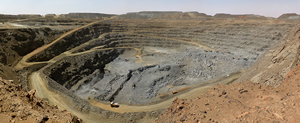Mauritania – Diversification of the Mining Sector
Country / Region: Mauritania / Africa
Focal Point: Mineral Resources
Begin of project: June 1, 2015
End of project: March 31, 2020
Status of project: June 15, 2020
 Gold and copper mine near Akjoujt
Source: BGR
Gold and copper mine near Akjoujt
Source: BGR
Mining is a key sector for Mauritania’s development. It is one of the country’s major sources of economic growth and generates roughly a third of state revenues. To date, however, mining has been largely focussed on extraction of iron and other metal ores (e. g. gold) and therefore exposed to severe fluctuations in world market prices. Moreover, commodities mined in Mauritania overwhelmingly go direct to export and are seldom processed within the country. A large part of the value is thus added abroad, meaning that mining does not contribute as much as it could to alleviating poverty.
Both in terms of diversification of the sector and establishment of value chains within Mauritania, non-metallic commodities (such as construction materials, phosphate and industrial minerals) offer promising and hitherto largely untapped potential. BGR’s technical cooperation project “Diversification of the Mauritanian Mining Sector” focusses, therefore, on production of these non-metallic commodities.
This BGR project is embedded in the development cooperation programme “Support to the Mining Sector in Mauritania” funded by the German Federal Ministry for Economic Cooperation and Development. In this project BGR is assisting the competent Ministry of Mines and its subsidiary department the Office Mauritanien de Recherches Géologiques (OMRG) to create the conditions for a more diversified mining sector.
One of the main obstacles to developing the mining of the country’s non-metallic commodities is insufficient data on mineral occurrences and resources. The project thus chose, in cooperation with the Ministry of Mines and the OMRG, two pilot commodities as examples: 1. limestone (a starting material for the cement industry) and 2. kaolin/clay (various applications from brick clay to ceramics). Areas with known, but as yet unsurveyed occurrences of these minerals were identified. Following orientation sampling in these areas, two limestone deposits (Nouadhibou, Kaedi) and one kaolin deposit (M’bout) were selected for detailed exploration including drilling. Within this process, staff at the project partner OMRG were also trained in the economic evaluation of mineral deposits.
For systematic data management, a digital database was designed and the required hardware and software were installed at OMRG. It is also planned to set up an information system (GIS) based on this database and make it available online. In parallel, specialist OMRG staff will be trained in the use and further extension of the database. Training in digital geological mapping by means of remote sensing technology, geological-technical evaluation of borehole data and 3D modelling of non-metallic mineral deposits also has been (or will be) provided to the partner’s specialists.
The objective is to enable OMRG’s employees to create high-quality data on the country’s non-metallic mineral resources and their economic geology in order to professionally advise potential investors and drive the diversification of Mauritania’s mining sector in terms of a sustainable form of development.
Partner:
- Ministère du Pétrole, de l’Énergie et des Mines, MPEM
- Office Mauritanie de Recherches Géologiques, OMRG